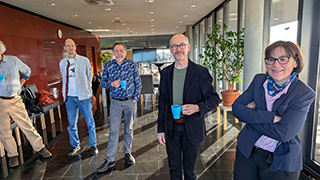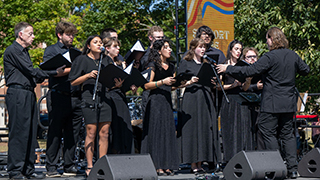Professor Investigates Instructional Communication Competencies and Strategies Needed for Gen Z in Latest Book - Seton Hall University
Thursday, December 2, 2021

After hearing anecdotes from faculty about their changing experiences with students in the classroom, Robinson, who currently serves as department chair and professor of communication in the College of Communication and the Arts, began to question how communication instructors are working with young people today to promote course engagement, student learning, and positive instructor-student interactions. Since communication programs increasingly integrate various teaching modalities, she identified a need to develop strategies for Gen Z students via communication elements likely to impact their student success.
"Faculty need to consistently and critically evaluate and reflect on teaching practices when working with learners," said Robinson. "This is especially true when considering how instructors communicate and interact with different students. Consequently, it’s important for faculty to acquaint themselves with generational research, current communication tools, and the competencies associated with them. Today’s students have experienced the world differently when it comes to interpersonal interactions, information, and technology. To best engage our current learners, it’s critical that faculty attend to their communication behaviors, channels, messages, and patterns. This text initiates a dialogue with faculty by faculty across the country regarding classroom happenings."
The text contains original research on teacher-student communication processes and behaviors in the classroom. Robinson noted one of her favorite contributions from Kristen Christman and Jessica McCall, who documented:
Classrooms reflect multiple spaces in that they are a(n)...recognized space that explores crisis and at times experiences it (e.g., the pandemic), natural-forced space, listening space, uncomfortable space, and extraordinary space — each of these spaces underscore the need for effective instructor communication practices and an understanding of the different communication skills required of educators in such a rich and vulnerable place.
Robinson hopes the book will serve as a professional development tool that helps colleagues who currently instruct, or plan to instruct, in communication classrooms and alternative learning settings beyond higher education.
Stephanie Kelly, Ph.D., communication scholar at North Carolina Agricultural and Technical State University, said of Communication Instruction:
With increasing frequency, I hear university educators critiqued in their pedagogy for making assumptions that 1) what was true of instructional research with Gen X samples is true of Gen Z learners, and 2) what is true about instructional practices that work well in the face-to-face classroom translates into the online classroom. This collection fills the knowledge gaps that create those assumptions, exploring characteristics unique to Gen Z learners and their lives immersed in technology. This is a very informative read for all educators!
Julie Reinhart, Ph.D., professor and director of the STEM Education Center at Saint Xavier University, also noted, "Robinson masterfully pulls together relevant research from experts in the field on topics relevant to college teaching."
"We are just beginning to explore and contemplate Generation Z students in the college classroom," said Robinson. "I hope this project initiates a conversation among faculty about the communication competencies, skills, and tools required of instructors and students alike so that we can develop and maintain dynamic learning spaces thoughtfully designed to communicate effectively with our changing students."
To read more about Communication Instruction, visit the Rowman & Littlefield website.
Categories: Arts and Culture, Education






